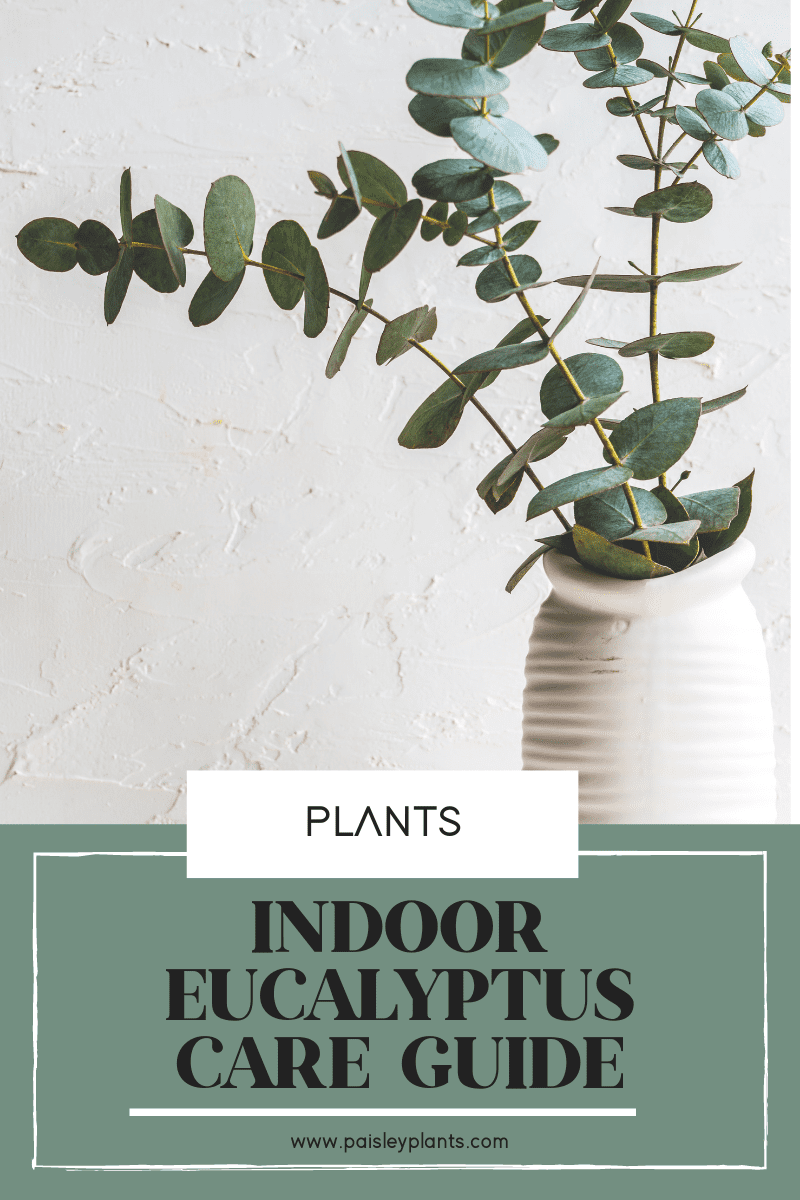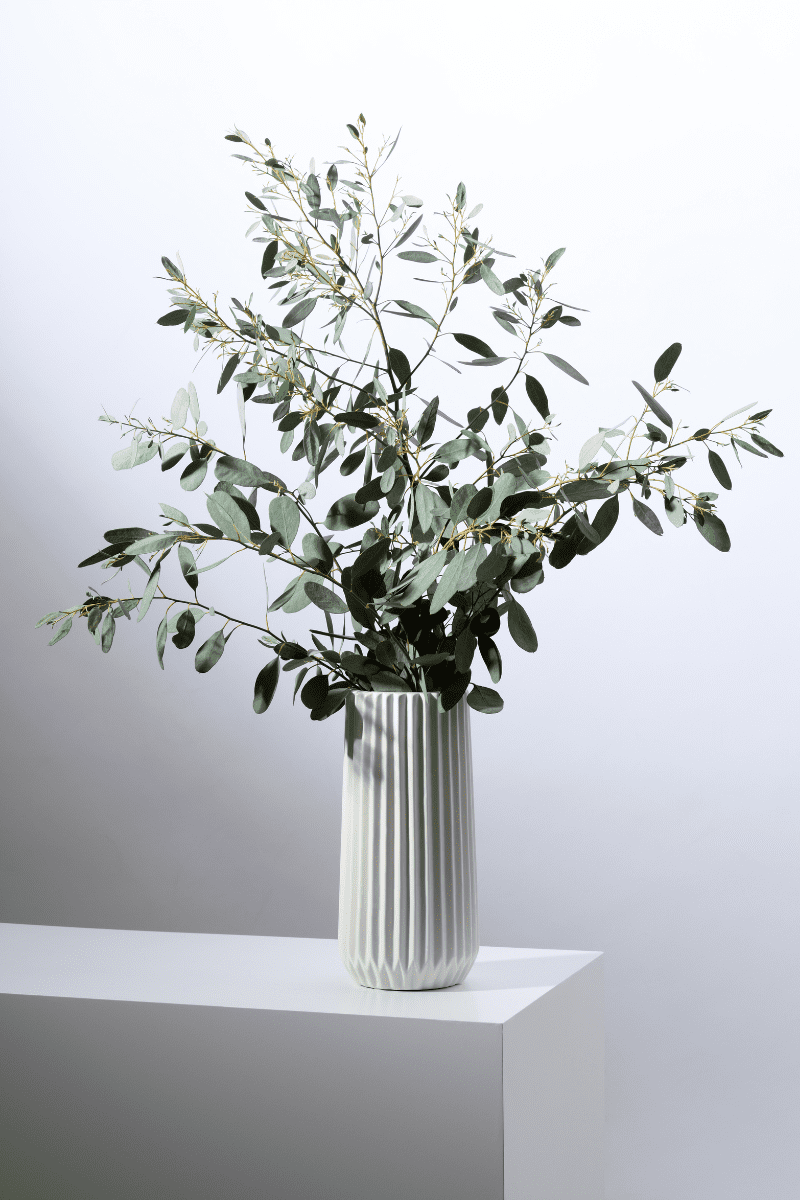Maybe you know it as the koala’s #1 preferred meal, or maybe you know it from the labels on many skin care products. But did you know that you can grow eucalyptus plants in the comfort of your own home?
With this ultimate indoor eucalyptus care guide, we’ll discuss how to successfully care for your eucalyptus plant.
Table of Contents
Eucalyptus Tree Background/History

Native to Australia, the Eucalyptus cinerea (or simply, eucalyptus), is one of the most recognizable household names in the plant world. The eucalyptus is also referred to as the argyle apple or the silver dollar plant.
In its native home of Australia, eucalyptus trees can reach a staggering height of 60 feet tall. However, when you grow eucalyptus indoors as a houseplant, your eucalyptus will only grow no more than 10 feet high indoors, which is a fraction of the height compared to its native counterpart, eucalyptus trees.
The leaves of the eucalyptus are a beautiful green-blue color that grows on reddish-brown bark. Eucalyptus is often revered by plant owners for their distinct aroma, which is reminiscent of menthol. These plants give off this scent when the leaves are slightly bruised.
All parts of these plants are toxic to both humans and pets (unless of course you have a pet koala!). We advise owners to exercise extreme caution when keeping eucalyptus indoors in the vicinity of small children or curious pets.
Discover pet friendly plants here!
Indoor Eucalyptus Plant Care Guide

Sun & Light for Indoor Eucalyptus Plants
Eucalyptus thrive on an abundance on sunlight. It is important that your eucalyptus receives a full day’s worth of cooking in the bright, indirect sunlight; at least 6 hours would be sufficient.
Soil Type
Eucalyptus are forgiving of a wide range of soil types. Though for container plants, it is especially important to select a potting mix that is well-draining, consider using the sun gro horticulture brand. We also recommend a standard potting soil with added perlite for extra drainage. Aim for a pH level that is in the acidic to neutral range.
Water
An established eucalyptus plant is somewhat drought tolerant and capable of withstanding being dry for brief periods of time. However, we strongly advise against long-term periods of drought; overtly dry conditions can cause leaves to fall off.
In order to encourage healthy growth and beautiful leaves, we recommend waiting to water your eucalyptus when the top couple inches of soil has dried up.
Fertilizer
A eucalyptus plant tends to deplete nutrients faster because it is in a container. You can help them grow by feeding it a fertilizer that is low in nitrogen.
Feed your eucalyptus throughout the spring and summer once a month. Cease all fertilization during the fall and winter when your plants are dormant to encourage a healthy growing pattern.
Temperature & Humidity Indoors
Being native to Australia, it’s no secret that the eucalyptus plant enjoys warm climates. As the owner, it is important to maintain the ideal temperature and humidity level that mimics the eucalyptus’ natural habitat in order to help the eucalyptus plants grow indoors.
The ideal temperature range for these indoor plants is somewhere between 65° to 75° F. Under no circumstances should you allow the temperatures to dip below 50° F, so please avoid placing it in areas such as near an air conditioning vent.
In addition, the eucalyptus plant also enjoys thriving and growing in a moderate level of humidity. In most cases, when keeping your eucalyptus plant indoors it will be more than comfortable in regular household humidity levels.
Pruning & Maintenance for Eucalyptus Leaves
These plants do not require a regular pruning regimen. However, it is beneficial to prune any leaves that are dead or damaged. We recommend pruning in the summertime during your usual gardening routine when it is in the middle of active growing periods.
Choosing a Container & Repotting
The two most important things to keep in mind when choosing a container for an indoor eucalyptus is that they do not enjoy having their roots disturbed and finding a pot that has good drainage.
It is beneficial to immediately select a larger pot so that you can avoid repotting altogether and the eucalyptus’ roots can grow undisrupted. A 5 gallon pot is a good choice to start with. con
In addition, it is also equally important to select pots that have good drainage. Drainage holes at the bottom of the pot will allow excess moisture to escape from the bottom. This will allow the soil to remain moist, but not waterlogged.
How to Propagate Eucalyptus
Eucalyptus plants can be propagated via stem cuttings. While propagating these plants is not always successful, it is an inexpensive way to multiply your eucalyptus. It is also difficult finding the seeds, even at nurseries.
Regardless, it is absolutely worth a shot to propagate your existing eucalyptus by following these steps:
- Take a small pot or propagation station and fill it with a potting mix comprised of 3:1 tree bark and perlite. Mix in a slow-releasing fertilizer according to the package instructions. Pre-moisten the potting soil.
- Take your pruning shears and cut off a piece of your eucalyptus plant just above the node of the leaves. The stem should be around 5 inches long and have a decent amount of leaves.
- Cut off the bottom leaves from the stem, exposing the leaf nodes. There should still be 2 to 3 leaves remaining at the top of the cutting.
- Dip the cut-end of the stem in hormone rooting powder. This will help increase the odds of rooting.
- Plant your stem cutting into the pot, the remaining leaves should be just above the surface of the soil.
- Keep the soil consistently moist and place the pot in a location in your home where it can receive bright, indirect light.
- It takes about one month for the cutting to root. When the eucalyptus starts growing, transfer it into a larger container.
Common Pests
The eucalyptus plant tends to be relatively pest-free, as long as it remains healthy and owners follow the eucalyptus plant care regimen. However, sick plants can become susceptible to attacks from pests, specifically the eucalyptus longhorned borer.
Borers tend to affect outdoor eucalyptus plants more than indoor. Regardless, if you move your eucalyptus plant outdoors, you can run the risk of bringing these pests inside.
Unfortunately, the longhorned borer is a difficult pest to rid yourself of while you’re gardening. There is a lot of specialized insecticides that target borers on the market, however this is merely a short-term solution. The best way to stop borers is by preventing them in the first place.
By following a meticulous regimen and keeping your eucalyptus plant healthy by referring back to this indoor eucalyptus care guide while gardening, you can significantly reduce the odds of ever encountering these pests.
Common Diseases
Eucalyptus plants can become susceptible to fungal diseases if they are not given proper care. Two of the most common examples of these diseases that can affect your eucalyptus plant include root rot or crown rot. The most common sign of these two fungal disease is brown spots forming on the leaves.
As we’ve discussed previously in this indoor eucalyptus care guide, the eucalyptus plant has a very sensitive root system, so it would be very risky to simply cut away the roots while gardening.
Treat your plant by spraying the base with a fungicide. If you are looking for a more natural natural approach, many plant experts recommend try spraying your plant with neem oil, which is horticultural oil that acts as a very effective fungicide.
Where to Buy
While the eucalyptus might seem like an intimidating plant to grow indoors, it is actually a very satisfying plant to care for, especially once you have followed this indoor eucalyptus care guide. This is an excellent plant for gardeners who want a little challenge and expand their plant repertoire.
This requires a plant owner who will be patient and help replicate the same conditions that they are native to.
With this helpful eucalyptus care guide, we hope that we’ve helped you in your endeavor in learning how to care and maintain your indoor eucalyptus plant.
Eucalyptus FAQ
Yes and no. While eucalyptus is not considered invasive, eucalyptus trees can compete with the native plants in your garden for resources. If you were to plant eucalyptus outdoors, it would be best to house this tree in a controlled environment, such as a safe, enclosed garden.
However, you may opt to take your eucalyptus plants outdoors in the sun when the weather gets warmer. This plant will grow with genuine sunlight and warmth, especially in the spring and summertime. Just make sure to bring your potted eucalyptus indoors when the weather gets too chilly.
Yes, eucalyptus are considered a fast-growing plants as long as the plant owners takes the necessary steps to provide the plants with the utmost attention. A well cared for eucalyptus can grow several feet within one year.
There is a distinct camphoraceous smell, which some plant articles describe as sharp and slightly medicinal — kind of like rosemary. It’s a multifaceted forest scent with hints of mint, honey, and citrus.
Eucalyptus gunnii is the most suitable eucalyptus for indoor growing because ordinarily it cannot grow more than 12 – 18 inches a year in a pot. It remains a reasonable size for several years.
Looking for more plant fun? Check out these plant posts!

